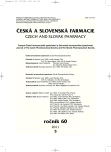-
Medical journals
- Career
The effect of three different elicitors on sanguinarine production in suspension cultures of a low-morphine variety of the opium poppy (Papaver somniferum L.)
Authors: Andrea Balážová; Víťazoslava Blanáriková; František Bilka; Andrea Bilková; Hana Kiňová Sepová
Authors‘ workplace: Univerzita Komenského v Bratislave, Farmaceutická fakulta, Katedra bunkovej a olekulárnej biológie liečiv, Slovenská republika
Published in: Čes. slov. Farm., 2011; 60, 237-240
Category: Original Articles
Overview
This paper is focused on the evaluation of the effect of three different elicitors on sanguinarine production in suspension cultures derived from a low-morphine variety of the opium poppy. The elicitors CdCl2, methyl jasmonate and a homogenate from the phytopathogenic fungus Botrytis cinerea have been administered into the growth media of 11-day-old suspension cultures. Their effect on the production of sanguinarine was monitored after 24, 48 and 72 h of exposure. The highest sanguinarine production was observed after 48 h of exposure to the biotic elicitor Botrytis cinerea, which increased the sanguinarine production 5.3-times. In the presence of CdCl2 at a concentration of 1 mmol.l-1 the content of sanguinarine increased linearly in suspension cultures and after 72 h of elicitation it was 2.3-times higher than in the non-elicited cultures. Opium poppy suspension cultures responded to methyl jasmonate elicitation by a moderate increase in sanguinane production after 24 and 48 h. A significant increase in the production of this secondary metabolite in cell suspension cultures was observed after 72 h of exposure and it was 3-times higher than the production of sanguinarine in non-elicited cultures.
Key words:
sanguinarine – methyl jasmonate – Botrytis cinerea – CdCl2 – elicitation – opium poppy
Sources
1. Facchini, P. J., Zenk, K. M., Kutchan, T. M.: Opium poppy blueprint for an alkaloid factory. Phytochemistry 2007; 23, 243–250.
2. Norn, S., Kruse, P. R., Kruse. E.: History of opium poppy and morphine. Dan. Medicinhist. Arbog. 2005; 33, 171–184.
3. Facchini, P. J., De Luka, V.: Opium poppy and Madagascar periwinkle: model non-model systems to investigate alkaloid biosynthesis in plants. Plant J. 2008; 54, 763–784.
4. http://www.incb.org/pdf/technical-reports/narcotic-drugs/2010/NAR_2010_E_Supply.pdf (5. 5. 2011).
5. Park, S. U., Facchini, P. J.: Agrobacterium rhizogenes-mediated transformation of opium poppy, Papaver somniferum L., and California poppy, Eschschotlzia californica Cham., root cultures. J. Exp. Bot. 2000; 51, 1005–1016.
6. Zdařilová, A., Malíková, J., Dvořák, Z., Ulrichová, J., Šimánek, V.: Kvartérní isochinolinové alkaloidy sanguinarin a helerythrin. Účinky in vitro a n vivo. Chem. Listy 2006; 100, 30–41.
7. Zulak, K. G., Khan, M. F., Alcantara, J., Schriemer, D. C., Facchini, P. J.: Plant Defense Responses in Opium Poppy Cell Cultures Revealed by Liquid Chromatography-Tandem Mass Spectrometry Proteomics. Mol. Cell. Proteomics 2009; 8, 86–98.
8. Collin, H. A.: Secondary product formation in plant tissue cultures. Plant Growth Reg. 2001; 34, 119–134.
9. Sánchez-Sampedro, A., Kim, H. K., Choi, Y. H., Verpoorte, R., Corchete, P.: Metabolomic alterations in elicitor treated Silybum marianum suspension cultures monitored by nuclear magnetic resonance spectroscopy, J. Biotech. 2007; 130, 133–142.
10. Murashige, T., Skoog, F.: A revised medium for rapid growth and bioassays with tobacco tissue cultures. Physiol Plant 1962; 15, 473–497.
11. Balažová, A., Bilka, F., Blanáriková, V., Pšenák, M.: Zmeny obsahu sanguinarínu a ktivity polyfenoloxidázy vplyvom fungálneho elicitora v uspenzných kultúrach maku siateho Papaver somniferum L. Čes. Slov. Farm. 2002; 51, 182–185.
12. Nadaská, M.: Pletivová kultúra maku (Papaver sp.) a rodukcia alkaloidov. Farm. Obzor 1991; LX, 221–224.
13. Šramková, Z., Faragó, J.: Založenie bunkovej suspenznej kultúry chmeľu obyčajného. Nova Biotech 2006; 6, 63-75. http://fpv.ucm.sk/katedry/ biotechnolog/ journal_nova_biotechnologica/revue_nova_biotechnolo gica_6_1/sramkova2006.pdf (5. 5. 2011).
14. Ondrejčák, F: Slovenské odrody maku siateho. http://www.makovepole.sk/index.php/mak-siaty/ slovenske-odrody-maku-siateho (8. 5. 2011).
15. Zheng, Z., Wu, M.: Cadmium treatment enhances the production of alkaloid secondary metabolites in Catharanthus roseus. Plant Sci. 2004; 166, 507–514.
16. Holková, I., Bezáková, L., Bilka, F., Balažová, A., Vanko, M., Blanáriková, V.: Involvement of lipoxygenase in elicitor-stimulated sanguinarine accumulation in Papaver somniferum suspension cultures. Plant Physiol Biochem. 2010; 48, 887–892.
17. Facchini, J. P., Penzes, C., Johnson, A. C., Bull, D.: Molecular characterization of berberine bridge enzyme genes from opium poppy. Plant Physiol. 1996; 112, 1669–1677.
18. Cho, H. Y., Son, S. Y., Rhee, H. S., Yoon, S. Y. H, Lee-Parson, C. W. T, Park, J. M.: Synergistic effects of sequential treatment with methyl jasmonate, salicylic acid and yeast extract on benzophenanthridine alkaloid accumulation and protein expression in Eschscholtzia californica suspension cultures. J. Biotech. 2008; 137, 117–122.
19. Ghosh, S., Ghosh, B., Jha, S.: Aluminium chloride enhances colchicine production in root cultures of Gloriosa superba. Biotech. Letters 2006; 28, 497–503.
20. Turner, J. G., Ellis, C., Devoto, A.: The Jasmonate Signal Pathway. The Plant Cell Supp. 2002; 14, 153–164.
Labels
Pharmacy Clinical pharmacology
Article was published inCzech and Slovak Pharmacy

2011 Issue 5-
All articles in this issue
- Clinical significance of cytochrome P450 genetic polymorphism – part III. cytochrome P450 2C19
- Alzheimer’s disease: aspects of contemporary pharmacological treatment
- Rhus hirta (L.) Sudw. – Phytochemical characteristics of the most widely cultivated representative of the Anacardiaceae in the Czech Republic
- The effect of three different elicitors on sanguinarine production in suspension cultures of a low-morphine variety of the opium poppy (Papaver somniferum L.)
- Viscosity and consistence measurements following Ph.B. 2009
-
Medicinal preparations in this country at the end of the 18th century
Part I – Introduction and liquid dosage forms
- Czech and Slovak Pharmacy
- Journal archive
- Current issue
- Online only
- About the journal
Most read in this issue- Alzheimer’s disease: aspects of contemporary pharmacological treatment
-
Medicinal preparations in this country at the end of the 18th century
Part I – Introduction and liquid dosage forms - Clinical significance of cytochrome P450 genetic polymorphism – part III. cytochrome P450 2C19
- Viscosity and consistence measurements following Ph.B. 2009
Login#ADS_BOTTOM_SCRIPTS#Forgotten passwordEnter the email address that you registered with. We will send you instructions on how to set a new password.
- Career

